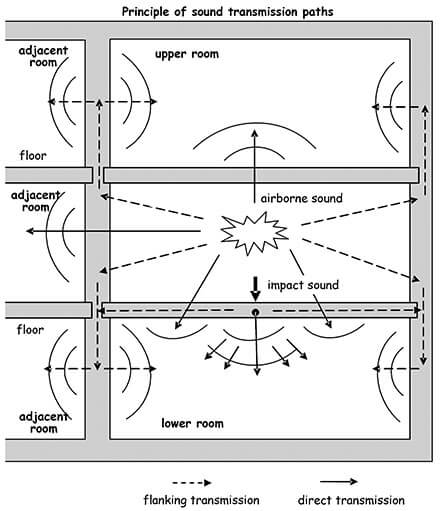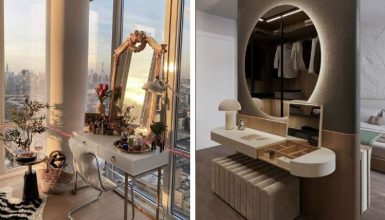There is nothing worse than living in a flat that constantly has unwanted sound from the noisy neighbors. Do you want to know how to soundproof an apartment floor? If your answer is yes, feel free to read this article to find out.
The floor is where you need to focus regarding sound control. However, it is not easy for those who live in rental homes since the rental agreement doesn’t allow them to change the flat’s construction.
This article will introduce you to some methods to create a better soundproof apartment floor system. Let’s dive right in!
Impact Noise Vs. Airborne Noise
To control the noise effectively, you need to understand the difference between the types of sound you are dealing with. There are two common sorts: impact noise and airborne noise.

Impact Noise
Impact noise, also known as structure-borne noise or footfall sound, occurs when two solid objects come in contact with one another, leading to producing and transmitting resonance.
The impact sound includes door banging, footsteps, furniture moving, etc. The sound vibrations spread throughout the floor and reach other rooms of the apartment. This type of noise is usually harder to address.
This type of sound depends on many factors, such as the impact force, the solid surface structure, or the radiation.
Impact noise can cause unpleasant feelings and in severe cases, some mental health problems, for example, anxiety, tension, decreased concentration and productivity, and so on.
Airborne Noise
Airborne sound is the opposite of impact noise, which transfers through the atmosphere and air. This type of noise can come from both inside and outside of your apartment unit, such as vacuum, TV, stereo systems, squeaky bed frame, loud fridge, traffic, pet, etc.
The sound waves transmit through the air and hit building elements such as ceiling drywall or different types of furniture, leading to a vibration. In this way, the sound travels through the other unit of residence and gets into your flat.
This kind of noise between floors and ceilings can have a major effect on human health. Similar to impact noise, it can cause hearing issues, high blood pressure, or psychological problems like anxiety and stress.
How to Soundproof a Floor In an Apartment
Below are some tips and tricks on soundproofing your apartment floor:
1. Carpeting And Rugs
Using carpets and rugs is the easiest and most economical way to soundproof your apartment floor. The harder the structure, the easier it for the sound to go through. Therefore, this soundproofing method is ideal for hard-material floors like laminate, wood, or tile.
Their dense nature and softness make it better for them to absorb both airborne and impact noise. The best type of rug and soundproof carpet for soundproofing is the multi-frayed, fuzzy ones.
One of the best rug materials is wool due to the fuzziness that can trap more sound. You want to choose the one with much fiber in the components for better sound deadening.
Also, try to avoid flat rugs due to their lack of foundation for sound captivation. Suppose you rent your flat; before you make any changes with it, make sure that you ask for the landlord’s permission first.
In case they don’t allow you to install a new layer of carpeting, you can use small area rugs for soundproofing. This is a good alternative since the rugs and carpets act the same way, as they both are sound absorbers that dampen the vibrations.
Keeping in mind is that this soundproofing solution works better for high to middle levels of frequency than for low-frequency noise.
2. Carpet Padding
Carpets work great as soundproof materials. However, to achieve the highest result, you want to install another thick pad underneath this piece of furniture.
Not only does it offer a cozier, softer surface for you to walk on, it also plays the role of a noise impediment by absorbing the sound. It can also extend the carpet’s life expectancy and minimize unwanted stains for an effortless cleaning process.
Plus, there are some elements you may like to pay attention to while purchasing carpet padding: material, thickness, density, and non-slip. A good product you can try is RUGPADUSA Superior Lock Rug Pad.
Here are the most common padding materials and their advantage:
- Foam: is the best for a limited budget.
- Fiber: works amazingly in preventing the traditional carpet from developing wrinkles and stretching.
- Rubber: is the most durable and long-lasting out of the three.
The thicker pad isn’t always a better choice since it can wrinkle your carpet underlayment. The pad with a thickness of 7/16 inches is the best choice for sound control and carpet warranty.
The density varies due to your apartment space and budget. Typically, the pads with a rating from three to five pounds are ideal for small flats since they are affordable and easy to replace.
For more spacious places, the ones with a high-density rating of six to ten pounds are the better option due to their wide coverage.
3. Acoustic Floor Underlayment
Another way to create a better sound control system is by making use of acoustic floor underlayment, which is a layer of flooring between the subflooring (usually Hardie board or plywood) and the final flooring (laminate, tile, or wood).
This layer offers the cushion to lessen foot lassitude that contributes to causing impact sound. Therefore, it eliminates noise resonating, creating a more efficient method to soundproof your apartment floor.
The most popular flooring soundproofing materials are foam, recycled rubber, cork sheets, and vinyl. These flooring materials are thick and dense, providing great impact deadening (such as footstep) and sound isolation.
This DIY technique is simple to do. First, if you have carpets or tiles on the floor, put them away to install the insulation underlayment. Ensure the floorboard is even with no protrusions like nails or other similar items.
You will need to add this underlayment layer on top of a vinyl floor or hardwood floor joists to create a sound-dampening barrier between floors. With the adhesive side faces downward, roll the acoustic layer out to cover the solid surface and cut out the excess material.
You can use nails if you need to secure the acoustic underlayment properly to all the edges of the ground. Continue to do so until you cover all the floor surfaces and the weak spots that you want.
A tip for better soundproofing apartment floors is to use a combination of different materials to prevent diverse sound frequencies. This soundproofing project can take a bit of time, but the outstanding result will speak for itself.
4. Interlocking Floor Mats
Suppose you do not have much money to spend on soundproofing floor products, then we highly recommend trying out interlocking floor mats. These mats assemble the jigsaw puzzle pieces that you often see in nursery schools or classes of elementary schools.
Since they are extremely popular and easy to use, finding these mats is not difficult, you can purchase them from anywhere. They come in many designs, sizes, and textures, giving you various choices to choose from. If you want the wood grain like the photo above, give IncStores Soft Wood Foam Tiles a try.
Plus, you can cut them into smaller pieces to fit multiple corners in your apartment. Most of the materials are foam, rubber, or vinyl.
Installing these soundproof floor mats is fun and straightforward. Lay one down into the apartment’s corner and continue working from there. Keep connecting the interlocking mats until you cover the entire edge floor.
The cleaning process is another benefit of these interlocking floor mats. You can clean the mats using only a brush and a mixture of soap and water. This soundproofing strategy doesn’t require much effort and time, so there is no reason not to try it out.
However, there is still a downside to this system. The mats can reduce the noise level but not as good as other products such as rugs or carpets. Therefore, if you are looking for a soundproofing technique to eliminate the noise entirely, this might not be the one for you.
5. Soundproofing Compounds
If you want to start a renovation project that doesn’t require rolling out the rugs and traditional carpets, soundproofing compounds like Green Glue are the go-to choice.
You can add a layer of glue between two separate floorings: the final flooring and the subflooring.
In this way, the amount of noise can reduce significantly since the glue blocks the sound waves and prevents them from traveling through solid construction environments and apartment building elements.
In addition to that, the glue’s adhesive secures the objects, preventing them from moving around. This type of glue is odorless, ensuring comfort for people and the environment.
Still, you would need help from a professional to achieve the best result. Before applying, make sure that the subflooring is clean and moisture-free.
Suppose you decide to do it yourself, read the precaution and instructions carefully. After distributing the glue on the subflooring evenly, place the fiberboard or underlayment on top of that layer of insulation.
The final step is installing your flooring with a carpet or a rug. Not only is this method effective, but it also makes cleaning less of a dull task. Simply sweep the floor at least once every two days to maintain your insulation layer.
The time required for the glue to fully activate and reach the highest performance for diminishing noise is around 30 days. So be patient during the process.
Conclusion
So there you have some simple ways to soundproof an apartment floor. All the above-mentioned techniques are effective, affordable, and easy enough to do by yourself. Hopefully, you can find yourself the best way to protect your apartment from unwanted noises.
Keep in mind that the living environment directly affects your living quality. If you have any trouble with the noise, you will want to find a way to solve it as swiftly as possible to avoid long-term effects on your and your family members’ health.
Even though soundproofing your apartment can take quite time, effort, and patience, the final result is worth all the hard work. Soon you can enjoy a quiet, peaceful space that no longer resonates with the noise from neighbors.
To turn your apartment, or room, into a quiet place to rest and relax, you may also want to read the following articles:
- 5 Quietest Flush Toilets on The Market
- Top 7 Ultra Quiet Ceiling Fans You Can Buy for Bedrooms
- 6 Effective Methods to Soundproof Your Room with Blankets





